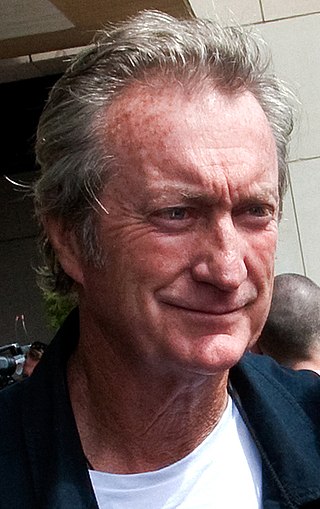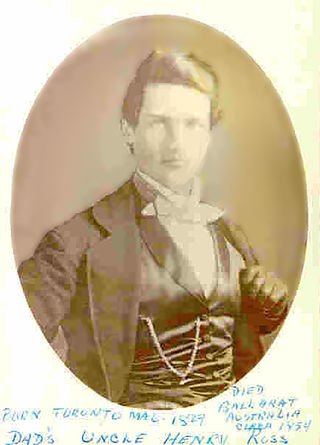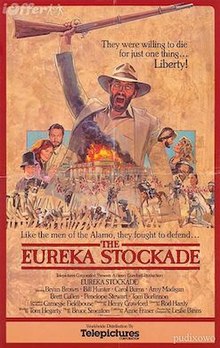
The Eureka Rebellion was a series of events involving gold miners who revolted against the British administration of the colony of Victoria, Australia during the Victorian gold rush. It culminated in the Battle of the Eureka Stockade, which took place on 3 December 1854 at Ballarat between the rebels and the colonial forces of Australia. The fighting left at least 27 dead and many injured, most of the casualties being rebels. There was a preceding period beginning in 1851 of peaceful demonstrations and civil disobedience on the Victorian goldfields. The miners, many of whom such as Raffaello Carboni came from Europe and were veterans of the Revolutions of 1848, had various grievances, chiefly the cost of mining permits and the officious way the system was enforced.

The Victorian gold rush was a period in the history of Victoria, Australia, approximately between 1851 and the late 1860s. It led to a period of extreme prosperity for the Australian colony and an influx of population growth and financial capital for Melbourne, which was dubbed "Marvellous Melbourne" as a result of the procurement of wealth.
Anthony Howard Lockett is a former Australian rules footballer who played for the St Kilda Football Club and Sydney Swans in the Australian Football League (AFL). Nicknamed "Plugger", he played as a full-forward and holds the VFL/AFL record for career goals, scoring 1,360 goals in total.

The Eureka Flag was flown at the Battle of the Eureka Stockade, which took place on 3 December 1854 at Ballarat in Victoria, Australia. It was the culmination of the 1851–1854 Eureka Rebellion on the Victorian goldfields. Gold miners protested the cost of mining permits, the officious way the colonial authorities enforced the system, and other grievances. An estimated crowd of over 10,000 demonstrators swore allegiance to the flag as a symbol of defiance at Bakery Hill on 29 November 1854. It was then flown over the Eureka Stockade during the battle that resulted in at least 27 deaths. Around 120 miners were arrested, and many others were badly wounded.

Peter Fintan Lalor was an Irish-Australian rebel and, later, politician who rose to fame for his leading role in the Eureka Rebellion, an event identified with the "birth of democracy" in Australia.

Bryan Neathway Brown AM is an Australian actor. He has performed in over eighty film and television projects since the late 1970s, both in his native Australia and abroad. Notable films include Breaker Morant (1980), Give My Regards to Broad Street (1984), F/X (1986), Tai-Pan (1986), Cocktail (1988), Gorillas in the Mist (1988), F/X2 (1991), Along Came Polly (2004), Australia (2008), Kill Me Three Times (2014) and Gods of Egypt (2016). He was nominated for a Golden Globe Award and an Emmy Award for his performance in the television miniseries The Thorn Birds (1983).

Henry Ross was a Canadian-Australian gold miner who died in the Eureka Rebellion at the Ballarat gold fields in the British Colony of Victoria, now the state of Victoria in Australia. Ross is particularly remembered for his part in the creation of the rebel miners' flag, since named the Eureka Flag.
Peter Julian Curtin was an Australian television and stage actor, whose career began when he joined the Melbourne Theatre Company, appearing in The Plough and the Stars with Wendy Hughes.

Eureka Stockade is a 1949 British film of the story surrounding Irish-Australian rebel and politician Peter Lalor and the gold miners' rebellion of 1854 at the Eureka Stockade in Ballarat, Victoria, in the Australian Western genre.

The Ballarat Reform League came into being in October 1853 and was officially constituted on 11 November 1854 at a mass meeting of miners in Ballarat, Victoria to protest against the Victorian government's mining policy and administration of the goldfields.
The proposed relocation of the North Melbourne Football Club has been an ongoing issue for both the club and the Australian Football League (AFL) since the 1980s. The North Melbourne Football Club has been involved in several proposals, especially during times of financial and on-field difficulty, to relocate and secure its future.
Eureka Stockade is a 1907 Australian silent film about the Eureka Rebellion. It was the second feature film made in Australia, following The Story of the Kelly Gang.

The Loyal Rebel is a 1915 Australian silent film directed by Alfred Rolfe set against the background of the Eureka Rebellion.
Igor Auzins is an Australian filmmaker. He joined Crawford Productions in 1969 and worked as a cameraman, then a director. He made documentaries for the South Australian Film Corporation, TV commercials, tele movies and features.

The Battle of the Eureka Stockade was fought in Ballarat, Victoria, on 3 December 1854, between gold miners and the colonial forces of Australia. It was the culmination of the 1851–1854 Eureka Rebellion during the Victorian gold rush. The fighting resulted in at least 27 deaths and many injuries, the majority of casualties being rebels. The miners had various grievances, chiefly the cost of mining permits and the officious way the system was enforced.

Since 2012, various theories have emerged, based on the Argus account of the Battle of the Eureka Stockade and an affidavit sworn by Private Hugh King three days later as to a flag being seized from a prisoner detained at the stockade, that a Union Jack, known as the Eureka Jack may also have been flown by the rebels. Readers of the Argus were told that: "The flag of the diggers, 'The Southern Cross,' as well as the 'Union Jack,' which they had to hoist underneath, were captured by the foot police."
The following bibliography includes notable sources concerning the Eureka Rebellion. This article is currently being expanded and revised.

The Eureka Rebellion, an 1854 gold miner's revolt in Victoria, Australia, has been the inspiration for numerous novels, poems, films, songs, plays and artworks. Much of Eureka folklore relies heavily on Raffaello Carboni's 1855 book, The Eureka Stockade, which is the first and only comprehensive eyewitness account of the uprising. The poet Henry Lawson wrote about Eureka, as have many novelists.

The Eureka Stockade was a crude battlement built and garrisoned by rebel gold miners at Ballarat in Australia during the Eureka Rebellion of 1854. It stood from 30 November until the Battle of the Eureka Stockade on 3 December. The exact dimensions and location of the stockade are a matter of debate among scholars. There are various contemporary representations of the Eureka Stockade, including the 1855 trial map and Eureka Slaughter by Charles Doudiet.

The Victorian gold rush led to an influx of foreign nationals, increasing the colony's population from 77,000 in 1851 to 198,496 in 1853. Many such as Raffaello Carboni had experienced the Revolutions of 1848. They supported the protest movement that formed on the goldfields in opposition to the mining tax system, ultimately leading to an armed uprising at Ballarat. It is currently known that the participants in the Battle of the Eureka Stockade on 3 December 1854 came from at least 23 different nations, including Australia, Canada, the United States of America, Jamaica, Mauritius, Russia, Norway, Finland, Sweden, Denmark, Poland, Switzerland, Italy, Greece, The Netherlands, Scotland, Ireland, England, Wales, Germany, France, Portugal and Spain. Carboni recalled that "We were of all nations and colours." During the 1855 Victorian High Treason trials the Argus court reporter observed that of "the first batch of prisoners brought up for examination, the four examined consisted of one Englishman, one Dane, one Italian, and one negro, and if that is not a foreign collection, we do not know what is." However, despite being present on the Ballarat gold fields, there is no record of any Chinese involvement at the Eureka Stockade. According to figures published by Professor Anne Beggs-Sunter, in her sample of 44 rebels, only one hailed from a non-European country.







